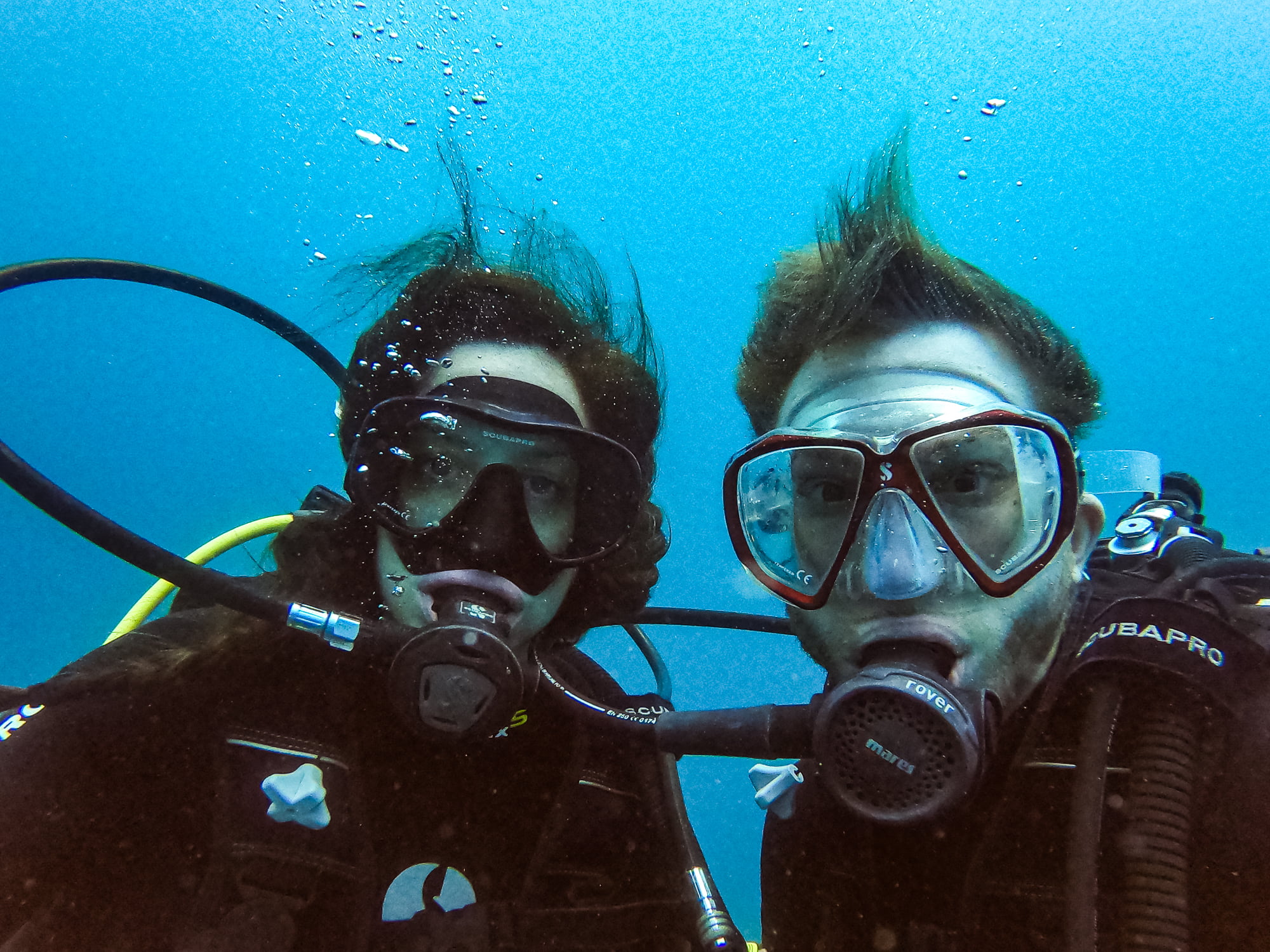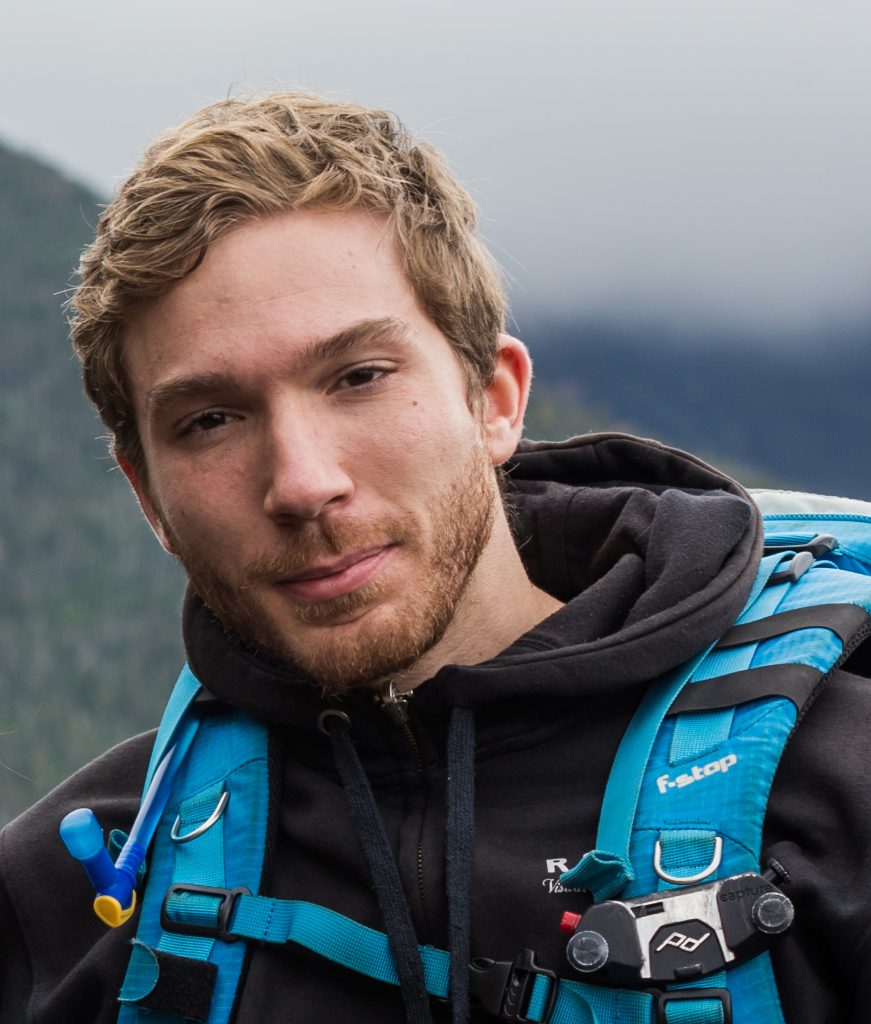March 12 2020
Today, it's one of the highlights of our stay, along with diving!
We join the diving center "Scuba Iguana"Early morning. Time for a briefing, then we cross the island of Santa Cruz in a "pick up", the only means of transport on the island 😛 Arriving at the northern end of the island, our boat for the diving trip is waiting for us.

We load the boat with all the equipment and then set off for a 1h30 boat ride in the direction of theBartolomé Island for our first dive.
We pick up two people on the way, who were on board a cruise ship. The trip is quite hectic and the seasickness makes itself felt a little. This is one of the drawbacks of this dive site. It requires quite a bit of boat transport to get there. There are other nearby sites just as interesting, such as Seymour North.
First dive: Bartlomé
We finally arrive on site. We get dressed: long-sleeved wet suit with long legs, jacket with regulator, mask, tank and fins. The most experienced divers form the first group, who will be the first to jump into the water. With 10 dives under our belts, we're classified in group 2. Meanwhile, the engine stops and we feel the force of the waves. It's stirring and giving us a hard time. We're burning up with all our gear on the boat, waiting for our turn to jump. We're not feeling very well.

Fortunately, we end up jumping into the water. The nausea subsides immediately, the wetsuit fills with water and refreshes us. We feel relieved.
This is our first dive without a descent rope and with current. But we're now wearing a new piece of equipment on our wrist, a dive computer, which we bought in Gaspésie after our seal dive. These computers, which are in fact watches, give us lots of information, such as our depth and water temperature. They also calculate decompression stop times on ascent, based on our dive time. Very useful for avoiding accidents.

We meet at the bottom of the water, do a few exercises to empty the mask and recover a lost regulator, and we're off for our underwater exploration. During the launch, we discover our first animals: fish and a curious sea lion. Marie descends slowly but surely. With her less-than-ideal ear anatomy (deviated sinuses, larger-than-normal nose organ), it's best to take care and go gradually, as air doesn't circulate as well from the nose to the ears as it does with most people. If this doesn't work and it's uncomfortable, go up a little, balance, then go down again, at your own pace. It's harder to do without a rope, but she manages just fine.
Marie wants to send the diving photos to the ENT specialist at Hôpital Notre-Dame who had told her 2 years earlier to stop diving and find another hobby. Bang, in your teeth Mrs. ENT who's never done any diving. Never stop at what comes out of a doctor's mouth.

An instructive aside for non-divers. To balance means to re-establish a pressure equilibrium in the eardrum in order to preserve its integrity. During descent, the outer surface of the eardrum is subjected to greater pressure (that of the water) than the inner surface, which is located on the side of the middle ear. The eardrum is therefore "pushed" towards the inside of the ear, causing discomfort and the risk of barotrauma to the ear. The simplest balancing method for beginners is the Valsalva maneuver, which involves breathing in through the nose, pinching the nose shut, closing the mouth and blowing moderately, so that the air flows towards the eardrum to balance the external water pressure. This will allow the eardrum to return to its original position. End of parenthesis.
The start of the dive was quiet, with only a few fish and crabs to be seen. Then, after about ten minutes, you find yourself surrounded by fish. They're everywhere. We also see lots of starfish and sharks. We spend about 10 minutes observing active sharks (white-tip sharks) in their natural environment. To do this, we have to hold on to a nearby rock wall to keep as still as possible, as the current is powerful.

The scenery is quite impressive. You can really see the relief of the island continuing underwater until you reach an underwater cliff that seems to plunge very deep indeed. The rock provides shelter for fish, and allows coral and other aquatic plants to thrive. It's a sight to behold. Towards the end of the dive, we were also lucky enough to spot an eagle ray. As usual, I'm the one who consumes the most air and the guide has to share oxygen with me, so that I can finish the dive at the same time as the others. After 52 minutes underwater, we surface to rejoin the boat.

On board, it's time for a well-deserved snack: Oreo cookie, soft bar and fresh fruit. We spot a few animals on the nearby rocks: boobies, sea lions and even a penguin.
Second dive: Cousins rock
After a short hour's drive on the boat, we arrive at the 2nd dive site of the day, Cousins rocklocated on the north side of Isla Bartolomé. At first glance, we see a simple, unimpressive rock rising out of the water. This one keeps its secret! We had no idea we'd discover underwater rock walls teeming with life!
This time, we're still seeing lots of fish, coral, a few sharks and sea turtles! We'll see several of them swimming more or less close to us.

These are truly beautiful diving spots. Our only regret is that we didn't see any of the famous manta rays or hammerhead sharks. In theory, the Seymour North dive site is more suitable for observing these rare specimens. But that's only a postponement!

After 53 minutes of diving, we surface and climb back on the boat. We go to an area where the sea is calmer, to ingest our dinner (or lunch for the French). This consists of fresh fish with an excellent sauce, white rice, salad and plantains.

We then set sail again, heading for the port north of Santa Cruz to take the opposite route. Once again, we cross the island in a pick-up truck. Arriving at the dive center, we fill in the logbooks with our parameters for the 2 dives (time, depth, animals seen, etc.). Looking at our photos after the dive, we realize that they don't match the beauty of the sites we visited. The best images are imprinted in our memory.

Dinner in town
We then set off to explore the few stores around the center, in search of coffee native to the islands. We're curious to see if growing coffee in volcanic soil brings a different taste! Our quest proves fruitless, and fatigue soon drives us back to the hotel. The diving had knocked us out a bit, as it always does when we practice this sport.
Later, we head back into town to eat on Binford Avenue. This section of the street is great, because it's pedestrianized and filled with tables from local eateries. It's like a giant terrace. Our choice is KF William we'd had suggested. We found it very simplistic for the price (around 13 US a plate), especially given the range of choices around. All dishes are served with the same coconut sauce, white rice and a choice of fish/shrimp or meat. We console ourselves by testing two ice-cream vendors, the first with guava and chocolate, the second with oréo and maracuya, which in Quebec we call passion fruit. The maracuya sorbet is a delight.
Finally, back to the hotel for the night. Tomorrow, we're up early to migrate to a new island, San Cristobal.

For the rest of our adventures, follow our Galapagos Diary:
Day1
Day2
Day3
Day4
Day5
Day6











